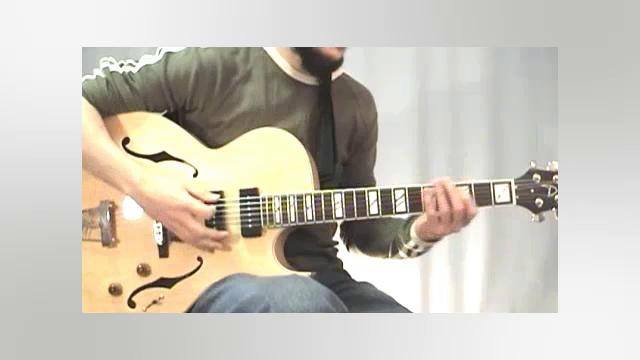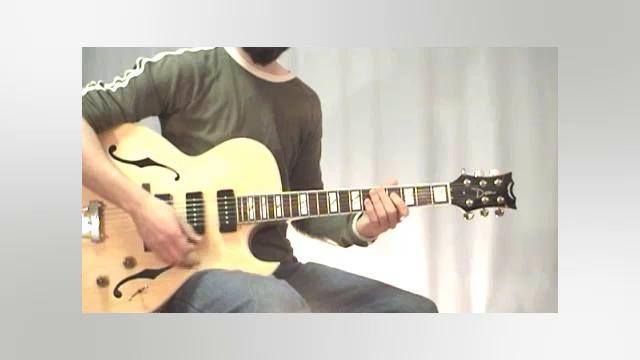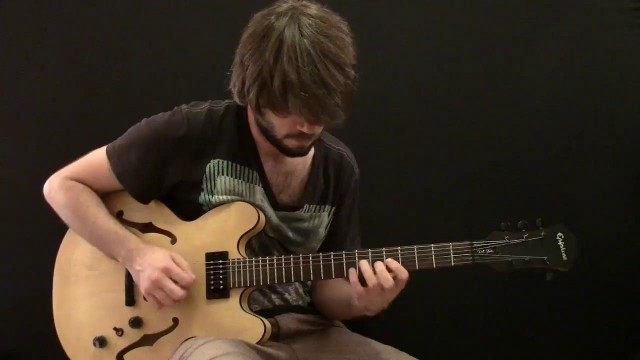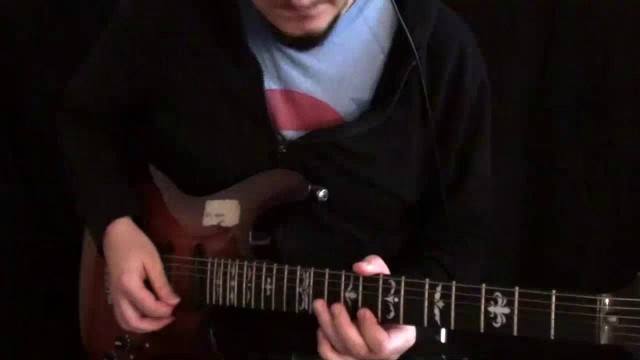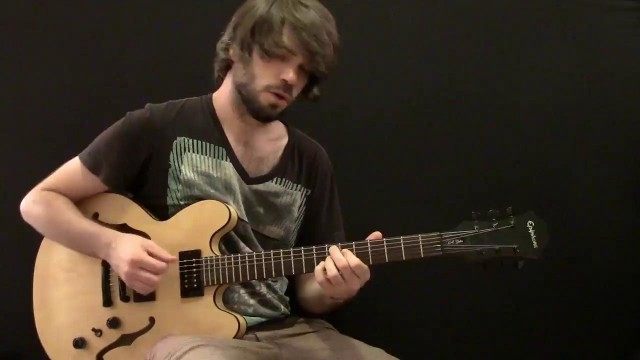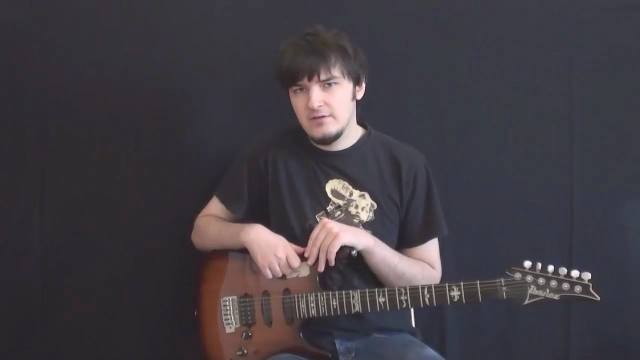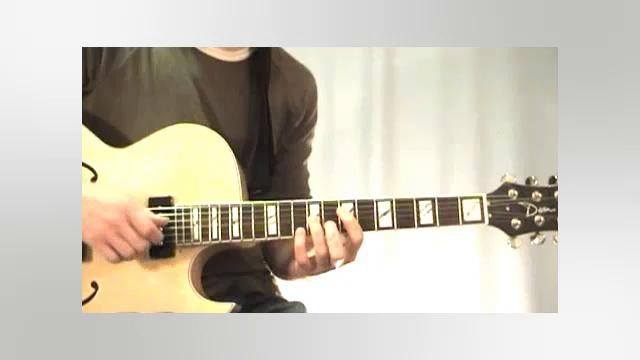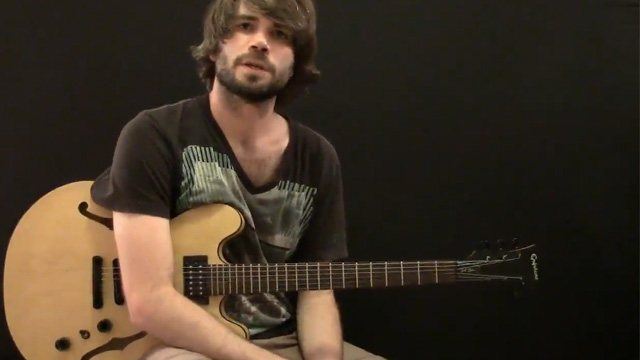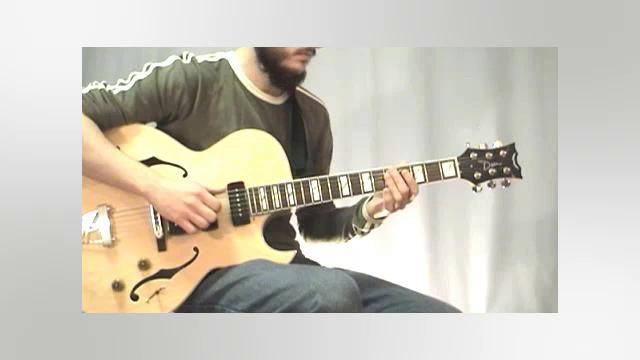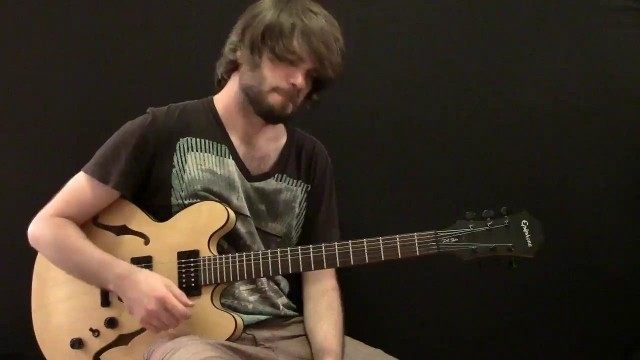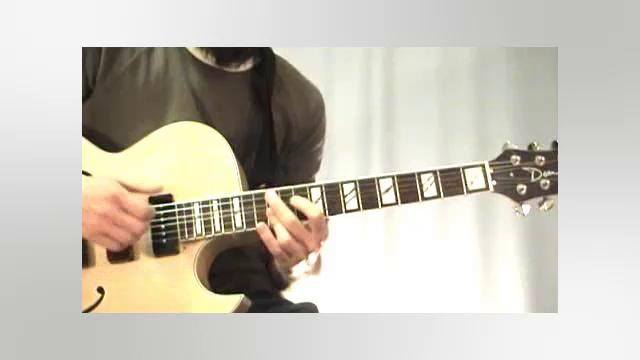Guide Tones. Part 1
This lesson will contain a lot more discussion about chord tones used than the following, so be sure to read carefully. If there is anything you don't understand please join me in the forums. Let's get right into understanding what Guide Tones are and how they can be used.
Example 1.
This phrase along with all following it throughout this tutorial will be over the same set of chords. As you can see, above the notation of example one are chord names Am G7 Cmaj7, this is to indicate which chord I am playing over at that point.
So, the first bar begins with a C note labeled with 'Lead in' above it. A lead in is a term to describe music that begins before a song. Often a phrase can begin at the end of one chord and continue through the next, so in this context we can say a phrase 'lead into the Am'. This is unrelated to Guide Tones though.
In the second bar I start with two 8th notes of G and rest until just before the next bar where I play a C note then an F# in the next bar. This is our first example of Guide Tone movement. The C note over an Am chord indicates the 3rd degree of Am and the F# indicates the 3rd degree of a D7 chord. Although this is a perfect example of using Guide Tones, the part I want to point out is the use of the G notes at the beginning of the second bar and you will see why in a moment.
The melody from the Am to the D7 although different notes, both have a repeating rhythmic pattern. Also as you can hear, the first two notes of each chord are only a semi tone away from each other. You can hear this as you play it, Am starts with the G notes then D7 starts with the F# notes. These are also guide tone movements. G being the 7th of Am and of-course F# being the 3rd of D7.
Finally from the D7 to the Gmaj7 we move from a C note to an F# again. The C representing the 7th degree of D7 and the F# representing the 7th of Gmaj7.
The line then descends to a D (the 5th of Gmaj7) and finally resolves on a B, the 3rd of Gmaj7.
So as we can see, there are two specific guide tone movements in this very simple phrase. The notes that join each bar, which have been indicated with the red lines. Also there is a more spread sense of guide tone movement from the beginning of the Am (the G note) chord to the D7 (the F#) which concludes at the very end of the phrase on the B note.
There you have it, Guide Tone movement in action. This very simple device is going to be put to use in more melodic ways during the following lessons.
Example 2.
I want you to make sure you have a go at playing this phrase before we discuss it. So play along with it, then join me again.
Ok, You will see two sets of red x marks. One set above and one below the score. Follow the bottom line with me first. Am begins, as marked with the X, with an A note. Then D7 starts with a D and Gmaj7 with a G. This can be called a 'Root Movement' as opposed to Guide Tone movement. It has the same effect of a Guide Tone line as it gives a good sense of when chords are being played. It does not however tell us what kind of chords are being played...are they major or minor?? are they dominant?
Now follow the top line. Just before the end of bar one the Am strikes a G note. G is the 7th of Am, from the beginning note A to the G we have an interval of a minor 7. Even though when you listen to a phrase you might not think "hey thats a minor 7th interval" in a cases like this, it does have an overall effect on your ears and how you perceive the music itself.
Stay with me and you will see what I'm getting at in a moment.
Bar two peaks with an F#, which we now know to be the 3rd of D7. This part of the phrase as we saw, started on the Root note and now peaks the 3rd degree one octave above. This is an interval of an 10th, although it can still serve the purpose of a major third. Essentially these intervals are the same thing, just an octave apart.
"Why is this important?"
Well, so far we have a root movement from A to the minor 7th above then a D to the 'major third' above. This motion of sound gives an impression, or an implied impression of the kind of chords that are being played.
If for example the D7 chord peaked with an F natural rather than an F#. The quality of that chord would sound more like a D minor chord rather than a Major chord, and since were playing over a D7 chord minor intervals are not going to give us a true impression of what progression we are actually playing through.
"But D7 is Dominant not Major" you might be thinking.
Correct, however, Dominant chords have a Major third anyway. So if we aren't going to play the b7th we may as well play the third and still give a general impression of the quality of this chord.
Moving on. About midway through the 3rd bar, I have marked a red X over an E note. This is the 6th of Gmaj7 and lands just before the F# (the 7th). The E note to my ears gives a better sense of the chord than the F# does, but you may hear it differently. The important part is that its a major 6th and is a strong note to this chord.
The line eventually resolves to the B note again (the 3rd of Gmaj7) which is a nice strong tone to end the phrase on.
So in summary, for this phrase, we had a Root Tone movement at the beginning of each bar. Also, each bar had a particular reference to important chordal tones, of which hopefully you were able to hear to a certain extent that each chord was of a different quality. That is to say, you can hear that the first chord is minor and the second was major(or dominant) and the third was major.
Example 3.
For this example you will firstly see a little symbol above the score with a quarter note and an 8th note a dash then two quarter notes tied together. This means that you play the phrase with a straight feel. You will hear that the first two phrases were played with more of a swing feel. Playing straight or swung is often a matter of taste, and you can play it how ever you want here. I just wanted to point that out to you.
Anyway, this example is slightly different to the previous two. We start on an E natural (the 3rd of Am) playing 8th notes until the same note again one octave higher. Then we rise to a G (the 7th) dropping to an F natural (the 6th) then rising one semi tone to an F# which is actually the b7 of Am. This is called a surround tone, or surrounding the tone, or sometimes an Approach tone. We use this device to anticipate the next chord. It is very common among Jazz improvisers to play a chord tone for the next chord before he actually reaches the chord itself.
This F# is held throughout the transition from Am to D7 so it gives your ears time to adjust to the chord change itself. We then rise to an A natural, marked with the red X, and fall down to a C then a B. This C could be considered as the 7th of D moving to the 3rd of G. Which is once again an example of anticipating the next chord before it has been played.
Alright. We are done! Over the next few lessons I will provide you with more examples of Guide Tones in action. By the end of it you will have a much better understanding of how we can outline chords effectively when improvising.








